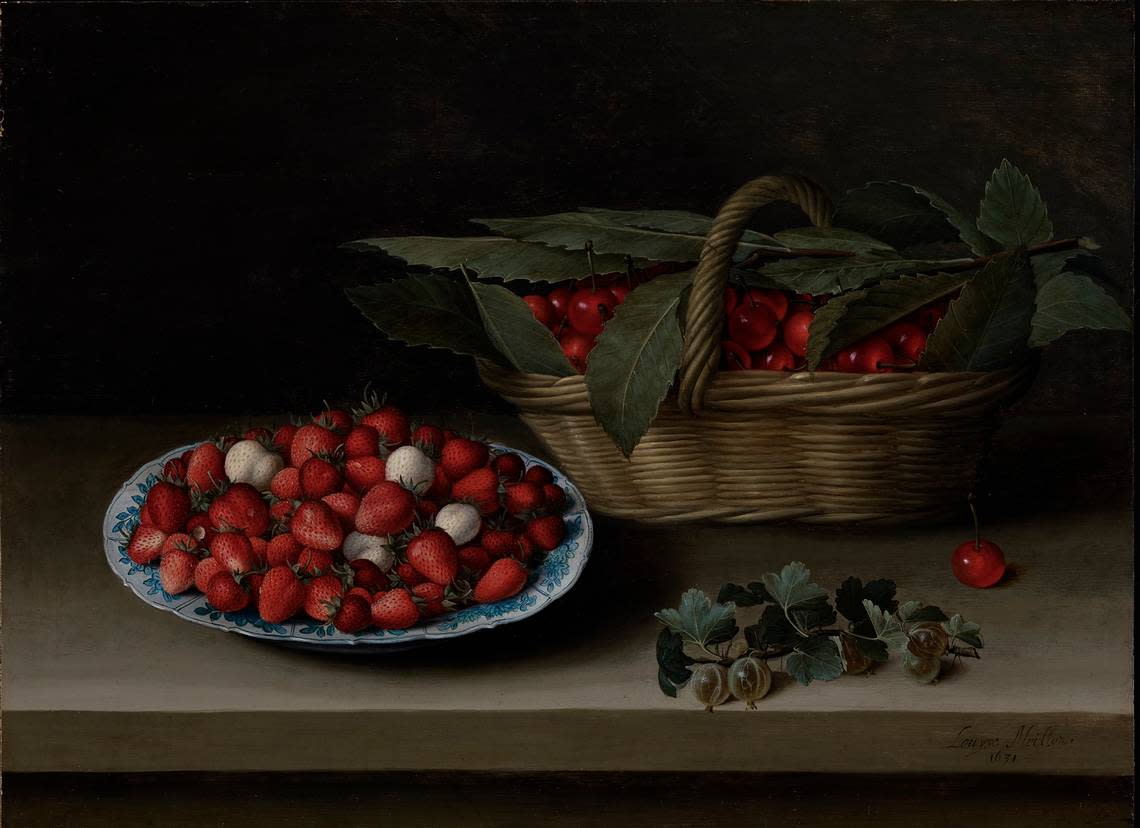A rare 1631 ‘masterpiece’ was just discovered in France. Now it’s in Fort Worth.

The Kimbell Art Museum in Fort Worth announced Friday it has acquired a rare, recently discovered “masterpiece” painted in 1631 by a French female artist.
The work — “Still Life with a Bowl of Strawberries, Basket of Cherries, and Branch of Gooseberries” by Louise Moillon — went on public view for the first time Friday at the Kimbell. The painting was unknown to scholars until it appeared at an auction in March, according to the museum.
Moillon, who lived from 1609 or 1610 to 1696, was an “unexpected genius” of her time and is considered one of the greatest French still-life painters of the 17th century, the Kimbell said in announcing the acquisition.
Only about 60 still lifes can be directly attributed to Moillon. While little is known about her career, “archival documents show that Moillon earned renown in her own time. Five of her paintings of fruits are listed in the inventory of King Charles I of England,” the museum said.
The painting had been in a family’s private collection in central France for many years, according to the Kimbell. It purchased the painting from an American collector through the New York dealer Adam Williams.
“Moillon’s paintings are remarkable for their elegance and restraint, the equilibrium of their compositions and a delicate technique that reveals the qualities of fresh, ripe fruits and vegetables, provoking a sense of serenity,” the museum said.
The still life is one of only a few by Moillon in American museum collections. The Kimbell, which is celebrating its 50th anniversary, also has a 1787 still life by Anne Vallayer-Coster, “Still Life with Mackerel,” which it acquired in 2019.
“The Kimbell Art Museum is delighted to add to its renowned collection what is unquestionably a masterpiece by Louise Moillon,” said Eric Lee, director of the Kimbell, in a statement. “The painting is an exceptionally well-preserved composition, a mysterious image of simple fruits painted in jewel tones on a wooden panel. It came to light for the first time just this year and is a prime example of Moillon’s keen observational skills and poetic approach to still life.”
Other recent acquisitions include a bronze vessel from the Shang dynasty, around 1600 to 1050 BC; a large sculpture, “The Mountain (La Montagne)“ designed by Aristide Maillol in 1937; a 16th-century alabaster statue of the Virgin and Child from the Atelier of Saint-Léger in Troyes, France; “Dog Guarding a Basket of Grapes,” an 1836 still life by Ferdinand Georg Waldmüller; and three pastels by Kimbell architect Louis I. Kahn.
More about the painting
The still life highlights “the appeal of the delectable fruit at its prime — ripe, firm and succulent. The fruit containers are placed on a closely framed wooden tabletop that tilts slightly forward and whose edge is brought near the foreground. A strong light from the upper left illuminates the glistening red objects against a dark, shadowy background.”
“The wild strawberries — fraises des bois — in a blue and white Wanli bowl range in shape, size and color, from deep garnet to white. Their soft, seeded texture suggests the delicacy of this fruit, whose spiky green calyxes remain intact to preserve their freshness, sweetness and aroma. Bright, glossy cherries — perhaps the prized tart cherries from Montmorency, north of Paris — are heaped in a rustic wicker basket under a protective shield of deep green chestnut leaves; their sawtooth edges, outlined in a lighter tone, discourage the temptation to pluck one of the polished spheres by its rugged stem. The little branch of gooseberries placed in the lower right foreground balances the basket and bowl; two of the gooseberries, jade-green globes, are strategically placed at the very edge of the table to create a tactile spatial illusion. Just above, a single ruby cherry invites admiration. Throughout the composition, Moillon creates a simple yet sophisticated balance of color and tone.”
“Moillon’s sincere approach to still life — excluding anecdote and symbolism — reflects 17th-century French agricultural reforms and the keen market in Paris for fresh fruit and vegetables. The nobility and bourgeoisie took pride in the fresh produce cultivated in their country estates and gardens. In the fields and orchards that abounded in the countryside outside the capital, women and children would pick the fruit late in the day so that it could be transported to the city by morning and sold at market. The peaches, plums, apricots, grapes, cherries and wild strawberries, along with vegetables such as artichokes and asparagus, that we see in Louise Moillon’s still lifes and market scenes represent the produce that would have been scrupulously selected for freshness and flavor by ladies, their cooks and their maidservants and proudly served at table.”
